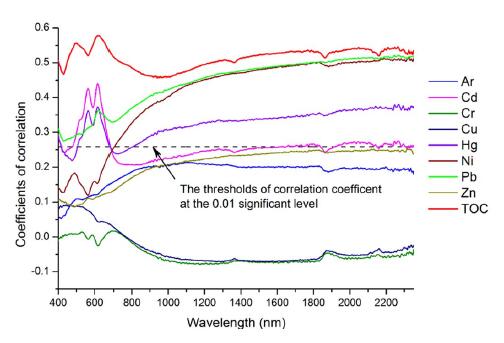
Heavy metals pollution in aquatic ecosystem has become a major threat to environmental safety and human health due to its high toxicity and persistence, especially for urban lakes. The distribution and retention of heavy metals in urban lake sediments is of crucial importance for the understanding of biogeochemical processes and development of lake management measures.
The conventional method of assessing heavy metals in soil is expensive and time-consuming. Therefore, a reliable and environment-friendly method is needed to rapidly assess the heavy metals contamination.
Visible and near-infrared diffuse reflectance spectroscopy (VNIRS, 350–2500 nm) has been shown to be very successful in estimating soil attributes, and heavy metal concentration in many ecosystems, including agricultural fields and natural lakes. However, since heavy metals are spectrally featureless, successful estimation of heavy metals through VNIRS is questionable.
JIANG Qinghu, supervised by Prof. LIU Feng from Wuhan Botanical Garden of the Chinese Academy of Sciences, explored the feasibility of using VNIRS to rapidly monitor heavy metal concentrations in urban lake sediments.
They found that VNIRS had limited practical applications in monitoring of heavy metals for surficial sediments of urban lake.
Given these undesired practices, this study demonstrated that VNIRS should not be recommended for heavy metals estimation in urban lake sediment.
In order to develop more robust VNIRS models for heavy metals prediction, the accumulation mechanism and the key "surrogate" correlations between heavy metals and spectrally-active constituents (e.g., total organic carbon) should be first confirmed.
Besides, more efforts should be focused on investigating the different accumulation mechanisms of heavy metals in aquatic ecosystem and other polluted stations, which will help in understanding the limited accuracy of VNIRS in heavy metals monitoring.
Results were published in Catena entitled "Feasibility of using visible and near-infrared reflectance spectroscopy to monitor heavy metal contaminants in urban lake sediment".
This study was funded by the Chinese National Key Development Program for Basic Research, the National Natural Science Foundation of China and the One Hundred Talent Program from the Chinese Academy of Sciences.

Distribution of the correlation coefficients between sediment properties (heavy metals and total organic carbon) contents and visible and near infrared reflectance spectra. (Image by JIANG Qinghu )

86-10-68597521 (day)
86-10-68597289 (night)

86-10-68511095 (day)
86-10-68512458 (night)

cas_en@cas.cn

52 Sanlihe Rd., Xicheng District,
Beijing, China (100864)

